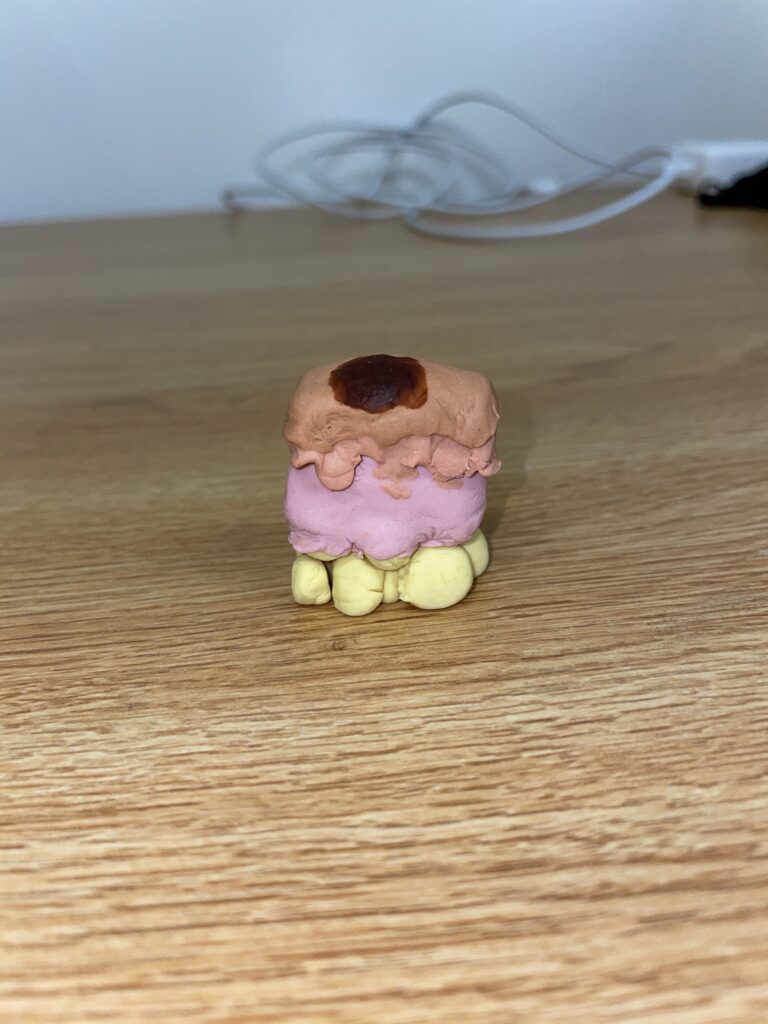The models below are made out of play doe, and each are layers of the skin. The three types of cancers each have something in common; each have very common risk factors and are treated the same, by Mohs micrographic surgery, and all are required to have frequent follow ups within 6 -12 months.

The basal cell carcinoma is the most common type of skin cancer worldwide. It has a slow rate of growing, but has the ability to be invasive if left untreated. The major risk factor for any kinds of skin cancer is expensive exposure of sunlight without anything to protect the epidermis.

The squamous cell carcinoma is the second most common type of skin cancer. It can occur on the face, neck, ears, scalp, and the extremities. It can occur to be flat, nodular, or plaque-like. The signs and symptoms are painful and tender around sore.

The melanoma is the most deadliest type of skin cancer. It is hard to diagnose a patient, but if found at an early stage it can be easily treated. If this type of cancer is detected at a later stage, it will be a lot more hard to manage and treat. Risk factor is exposure to sun, having light, far skin, eyes and hair.
Essay Portion:
The objective I chose for the STEAM project are three types of skin cancer. Squamous cell carcinoma, basal cell carcinoma, and melanoma. For this project, I bought play-dough to make the layers of the skin along with the cancer cells that invade the skin. I chose this topic for the project because the type of cancer is most common in humans.
The most common type of skin cancer is the basal cell carcinoma, and there are a lot of patients that are diagnosed with it worldwide. It occurs in patients after the age of 40, and is most common in females. The gorlin syndrome is associated with the disorders that affect the bones, skin, eyes, and the nervous system, and it increases the risk of developing basal cell carcinoma.The hedgehog (Hh) pathway acts as a oncogene that’s normally suppressed by the patched 1 (PTCH1) gene. UV radiation is the major environmental risk factor, acute irregular exposure especially during childhood or teenage years the risk becomes higher throughout lifetime. Another risk factor would be the skin’s ability to tan, even indoor tanning, micro injuries, scars, chronic ulcerations of the lower extremities, and prolonged exposure to chemical agents. The basal cell carcinoma has the ability to grow and can be very invasive, but has a slow rate of progression. Treatment for BCC is Mohs surgery and long term follow ups after procedures.
Cutaneous squamous cell carcinoma, also known as squamous cell carcinoma is the second most common skin cancer in the United States. Squamous cell carcinoma is most common for patients who are at the age of 50 years old and older, and is more common in male patients. The primary risk factor for this specific type of skin cancer is excessive exposure to UV solar radiation, cancer causing chemicals such as smoking cigarettes, severe scar burns, and sores or ulcers that’s been current for a long period of time. The p53 gene is a type of protein cell, or a tumor suppressor gene. The p53 stops the cells with mutated or damaged genes from reproducing. The cutaneous squamous cell carcinoma can occur on the face, neck, and the extremities. The color may vary depending on the tones of the tissue, they can occur as scaly, crusting, and ulcerations, and the cancer can occur as being flat, nodular, or plaque-like. The only treatments for squamous cell carcinoma is surgery such as the Mohs micrographic surgery, and the requirement is to have 6-12 month follow ups, and patients are advised to protect their skin from exposure to the sun.
Melanoma is by far the deadliest skin cancer worldwide, and it is the most difficult to diagnose to a patient and hard to treat. If the cancer cell is detected early it is more likely to be treated easily, but if found late it will certainly be difficult to treat. The melanoma cancer can be found on the surface of the skin but can be found in other locations such as the GI tract and even in the brain. There have been several drugs that’s been developed over the last decade, and they are all improving prognosis of patients with metastatic melanoma. It is more common in those who have fair, light skin, eyes, and hair.
I chose this topic because there are many studies about skin cancers that are caused by exposure to the sun and other risk factors that may contribute to either one of the three skin cancers I did some research on. It is very important to take care of your skin and use clothing that lessens the amount of skin being exposed to the UV rays coming from the sun. I think more people should know about the importance of using sunscreen and protecting yourself from these types of risk factors.
Works Cited
Davis, Lauren E et al. “Current state of melanoma diagnosis and treatment.” Cancer biology & therapy vol. 20,11 (2019): 1366-1379. doi:10.1080/15384047.2019.1640032
Dika, Emi et al. “Basal Cell Carcinoma: A Comprehensive Review.” International journal of molecular sciences vol. 21,15 5572. 4 Aug. 2020, doi:10.3390/ijms21155572
Howell JY, Ramsey ML. Squamous Cell Skin Cancer. [Updated 2022 Jan 21]. In: StatPearls [Internet]. Treasure Island (FL): StatPearls Publishing; 2022 Jan-. Available from: https://www.ncbi.nlm.nih.gov/books/NBK441939/

This piece by Autumn Phillip focuses on illustrating the three major types of skin cancer; squamous cell carcinoma, basal cell carcinoma, and melanoma. Autumn used clay modelling to show the various layers of the skin and how each type of cancer affects the skin. In the accompanying written piece, Autumn describes the pathology of each form including risk factors, prevalence, genetic influences, appearance, and growth progression. Firstly, the basal cell carcinoma type is identified as the most prevalent, occurring mostly in females over the age of 40. Risk factors for this type include Gorlin syndrome, the hedgehog (hH) oncogene pathway, UV radiation, and additional environmental influences. Treatment for BCC involves Mohs surgery and long-term monitoring. The second most common skin cancer is identified as the cutaneous squamous cell carcinoma, occurring mostly in males over the age of 50. This type also involves genetic risk factors (the p53 gene) and environmental factors including UV radiation, chemicals, and burns. Squamous cell carcinomas are also treated by Mohs surgery and long-term monitoring. Thirdly, the deadliest form of skin cancer is identified as the melanoma which is also notoriously difficult to identify and treat. The effectiveness of treatment for melanoma is increased when detected early and can be treated by several drug options. Great project!